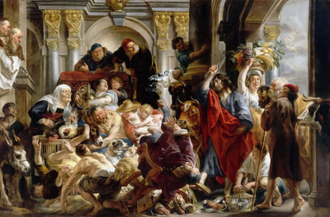Gospel in Art: You have turned God's house into a robbers' den

Christ driving the money-changers from the Temple, by Cecco del Caravaggio, 1610 © Gemäldegalerie, Berlin
Source: Christian Art
Gospel of 24 November 2023
Luke 19:45-48
Jesus went into the Temple and began driving out those who were selling. 'According to scripture,' he said 'my house will be a house of prayer. But you have turned it into a robbers' den.'
He taught in the Temple every day. The chief priests and the scribes, with the support of the leading citizens, tried to do away with him, but they did not see how they could carry this out because the people as a whole hung on his words.
Reflection on the painting
Our painting is by Cecco del Caravaggio, an early 17th-century follower of Caravaggio. Cecco responded in his own unique style to the original manner of Caravaggio's dramatic naturalism. None of Cecco's works are signed or dated, and therefore we don't quite know the full extent of his oeuvre. Among the old master painters, many if not most paintings were left unsigned, especially in the pre-Renaissance period. Consistency, quality and uniqueness in style were prized above needing a signature of the artist. Even the all-time great Michelangelo did not sign any of his works. The only signature we have for any work of Michelangelo is right across the chest of the Madonna on his Pietà sculpture at St Peter's. This was done after the work was exhibited and people thought the work to be done by a different sculptor (Cristoforo Solari). Michelangelo overheard the comments, was furious people did not realise it was him and went in at night to carved his name across Our Lady's chest. We can still see the haste and nervousness of his hand in his signature.
In our painting by Cecco, we see Christ holding a whip and storming into the theatrically staged room. Money lenders are falling off their chairs, coins flying through the air. Jesus is flanked by a large bull, referring to Luke, the author of our Gospel. Luke is symbolised by a bull in the arts, since his gospel begins with the priest Zechariah sacrificing in the Temple, with the bull representing the sacrifice of Christ to his Church. The bull was a figure of sacrifice, service and strength.
What Jesus is objecting to in today's Gospel reading is the corruption of the sacred, which had made its way into the temple itself. The house of prayer had been handed over to the false gods of money and greed. Jesus challenges therefore the goings-on in the temple itself. And yes, in most of the artworks depicting this scene Jesus is being portrayed as angry, but the root of his issue was mainly disappointment. With one strike (literally), he re-adjusted the focus of the temple back to being a place of worship for his Father. Many times we too have entered our parish churches being distracted, almost forgetting that God is present. Today's reading reminds us of God's presence in our churches, especially in the tabernacle.
LINKS
Gospel in Art: https://christian.art/
Today's Reflection: https://christian.art/daily-gospel-reading/luke-19-45-48-2023/


















